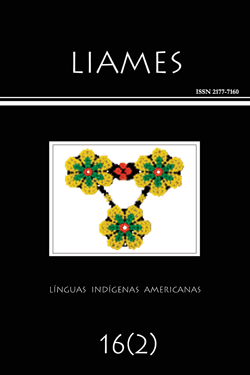Abstract
In this paper, I present an analysis of the relationship between abstract Case assignment and the morphological markers in Ka’apor. I show that this language has some alternations on subject and object marking, but those are the result of different processes. Regarding the subject, I argue that the language assigns different types of abstract Cases. Some subjects receive Case based on structural relations; while others get inherent Case, if they bear some specific thematic-role. On the other hand, objects always receive the same abstract Case, based on structural relations. However, they can exhibit different morphological markers, depending on how high they are in a scale of animacy and definitiness.References
Bossong, G. (1991). Differential object marking in Romance and beyond. In D. Wanner; D. Kibbee. (ed.). New Analyses in Romance Linguistics. Amsterdam: Benjamins.
Butt, M.; King, T. (2004). The status of Case. In Clause Structure in South Asian. Languages, vol. 61(3): 153-198.
Cabana, Nasle Maria (2013). Relação não biunívoca entre caso morfológico e Caso abstrato na língua Ka’apor. Anais do Silel, vol. 3(1) Uberlândia: UDUFU.
Cabana, Nasle Maria (2014). Marcação diferencial do sujeito na língua Ka’apor. Revista LinguíStica vol. 10(2): 180-198.
Caldas, Raimunda Benedita Cristina (2001) Aspecto, modo de ação e modalidade na língua Ka’apor (Dissertação de mestrado em Letras: Linguística e Teoria Literária). Belém: Centro de Letras e Artes, Universidade Federal do Pará.
Caldas, Raimunda Benedita Cristina (2009). Uma proposta de dicionário para a língua Ka’apor (Tese de doutorado em Linguística). Brasília: Instituto de Letras, Universidade de Brasília, Brasília.
Chomsky, Noam (1993 [1981]). Lectures on government and binding: The Pisa Lectures. Mouton de Gruyter.
Duarte, Fábio Bonfim; Garcia, Mário Alexandre (2006). Ergatividade cindida, papel temático e causativização na língua Ka’apor. Revista de Estudos da Linguagem 14(2): 277-315.
Duarte, Fábio Bonfim (2014). On the semantics of affectedness and its implications for argument structure in the Ka'apor language. Revista LinguíStica 10(1): 99-122.
Enç, Murvet. (1991) The semantics of specificity. Linguistic Inquiry 22 (1):1-25.
Givón, T. (1978) Definiteness and referentiality. In Joseph H. Greenberg (ed.). Universals of human language,v. 4. Stanford: Stanford University Press.
Kakumasu, James (1986). Urubu-Ka’por. In Desmond C. Derbyshire; Geoffrey K. Pullum (eds.). Handbook of Amazonian Languages, vol. 1: 326-403. New York. Mouton de Gruyter.
Legate, Julie Anne (winter 2008) Morphological and abstract case. Linguistic Inquiry 39(1):. 55-101.
Silverstein, Michael (1976). Hierarchy of features and ergativity. In R. M. W. Dixon (ed.). Grammatical categories in Australian languages, pp. 112-171. New Jersey: Humanities Press.
Silva, Tabita Fernandes (2001). Classes verbais e algumas questões pragmáticas em Ka’apor (Dissertação de mestrado). Belém: Universidade Federal do Para.
Ura, Hiryuki (2001). Case. In Baltin, Mark; Collins, Chris (eds.). The handbook of contemporary syntactic theory, pp. 334-374. Oxford: Blackwell.
Woolford, Ellen (2006). Case agreement mismatches. In Cedric Boec (ed.). Agreement Systems, pp. 299-314. Amsterdanm/Philadelphia: John Benjamins Publishing Company.
Woolford, Ellen (1997). Four-way case systems: ergative, nominative, objective e accusative. Natural language and linguistic theory, pp. 181-227.
Woolford, Ellen (2008). Differential subject marking at argument structure, syntax, and PF. In Helen Hoop,; Peter Swart (eds.). Differential subject Marking, pp. 17-40. Massachusetts.
The LIAMES: Línguas Indígenas Americanas uses the Creative Commons license (CC), thus preserving the integrity of the articles in an open access environment.


